Abstract
Natural disasters and warfare lead to the destruction of city buildings and infrastructure, leaving large numbers of people homeless. The rebuilding of destroyed cities needs to be carried out promptly while maintaining a balance between construction quality and duration. Rework due to defects and the lengthy approval of non-conformances significantly increases the duration of construction. This study aimed to develop a decision support system to fix or negotiate strategies to address construction defects, depending on their level of risk. The paper addresses the following objectives: classifying defects by the quality of construction that they affect; building a tree of construction defect risks; and developing an artificial neural network (ANN) to assess the defect risk. The weights of the links are represented by posterior probabilities of damage calculated using the Bayes’ theorem in the pre-training stage. The ANN has been adapted to cast-in-place reinforced concrete structures. When training the resulting ANN on a sample of precedents, the test sample demonstrated convergence and low errors. The resulting model will accelerate construction by automating assessments of defect severity and reducing the time spent on reworking defects with low quality risk.
1. Introduction
Residential communities, and sometimes, entire cities, are destroyed as a result of warfare or natural disasters, with their residents losing their homes and apartments while key infrastructure supporting normal life stops functioning during the permanent relocation of residents [1]. In similar conditions, when rebuilding cities, the construction of buildings must be carried out promptly and with a sufficient level of quality. In such a situation, the duration of the construction project is the decisive criterion [2]. Moreover, the rebuilt building must have a sufficient level of quality so that it could be used for its intended purpose [3]. The regulatory and industry literature details all requirements for the quality of work in civil engineering. The problem is that all these requirements are intended for construction under normal conditions, such as scheduled urban development, the implementation of a government housing policy, commercial investment projects, etc. There are a number of studies in the scientific community dedicated to the construction of prefabricated buildings and temporary housing for the resettlement of people who have lost their homes [4,5,6,7,8]; however, rebuilding urban infrastructure and cities itself is a problem that is not sufficiently studied. The rebuilding of cities after destruction is complicated by a number of factors, so it has a longer duration, which adversely affects the population [9]. There are requirements for construction quality applicable to the rebuilding of destroyed cities, when buildings need to be constructed faster than in normal conditions. Applying the existing requirements for construction quality and safety will prevent the rebuilding of buildings ahead of regulatory construction timelines.
Construction quality is ensured through a complex of various factors: the qualification of workers and engineers, a quality control system, design and process documentation, machinery, and tools. In the case of city rebuilding, the quality of construction is negatively affected by a large number of factors that complicate the work. City rebuilding requires prompt fulfillment of all pre-construction FEED and design procedure preparations [10]. Conducting engineering surveys of destroyed buildings is complicated by a number of factors, and takes more time than under normal conditions [11]. In such a situation, engineering surveys are often carried out in parallel with the development of design documentation, with design documentation undergoing accelerated verification and approval procedures for contractors to start work. As a result, detailed design and engineering documentation used for city rebuilding often have inaccuracies, errors, and deficiencies, which adversely affect the quality of construction [12]. When rebuilding cities after warfare or natural disasters, contractors are selected via a simplified and accelerated bidding procedure against cost and timing criteria, without multi-stage competitions, without reviewing their portfolios and qualifications, etc. In such cases, the contractor is often a state construction organization [13]. In this regard, the contractor involved in the rebuilding of destroyed cities often does not have a high level of quality control organization and may lack the necessary technical resources. In the case of city quality control, the initial preparatory period is almost non-existent; thus, the contractor does not always have time to recruit the necessary number of highly skilled engineers and workers. Specific conditions of city rebuilding at all stages require a scientific approach and the development of various decision support systems [14].
Summarizing the above, we can conclude that all factors that influence the quality of construction initially have a low weight in the specific conditions of city rebuilding after natural disasters or warfare. If the contractor initially has low capabilities affecting the quality of construction, this leads to a large number of construction defects of different types, which, in turn, leads to longer construction times due to rework or downtime caused by the search for more qualified contractors. However, in addition, there are external risk factors [15] that complicate the quality of construction even for highly organized contractors: infrastructure disruption, problems with energy supply [16], and disruptions in logistics [17]. Therefore, in order to accelerate construction in the specific conditions of rebuilding destroyed cities, we need to establish more flexible requirements for the quality of construction that allow for defects while maintaining the overall quality of construction.
Currently, there are no regulatory documents that set out nominal requirements for the quality and safety of construction during the rebuilding of destroyed cities. At the same time, there are no guidelines for determining the necessary and sufficient range of requirements for the quality of construction depending on the project and construction conditions, particularly for the rebuilding of cities, when construction timing is decisive. There are some scientific studies on instrumental quality assessment and determination of the damage causes [18], and separate studies on the assessment of the significance of cracks in monolithic structures for the reliability and safety of operation [19]; however, these studies do not establish a methodological approach to assess the significance of various defects and the degree of their joint influence on the quality of structures according to several criteria.
The solution to this problem is only possible with the use of a risk-based approach [20] to assess the significance of construction defects. The risk-based approach has been successfully used to assess the duration and cost risks of construction projects [21,22,23], as well as other construction project risks [24]. This study aimed to develop a decision support model for construction quality control systems in the rebuilding of destroyed cities, when construction timing is the decisive criterion of effectiveness. The objectives of this study were reviewing the literature on the current topic; building a tree of construction quality risks; classifying defects by quality, and developing a model for assessing the defect risk; and training and validating the resulting model for cast-in-place reinforced concrete structures. The theoretical value of this study consists of the creation of new approaches for the assessment of construction defects and their classification based on the construction quality risk. Its practical value lies in the accelerated timing of construction due to preventing wasted time on reworking defects that do not carry a significant risk to the quality of work, as well as through the automation of the decision-making process to assess the significance of the defect.
2. Literature Review
Contemporary construction problems during the rebuilding of cities after natural disasters and warfare are highly relevant; however, scientific research in this area has not really advanced. There have been some studies on the introduction of information modeling into the process of project documentation approval and permission process [10], and the need to introduce special urban planning technologies for city rebuilding has been established [2,12,25]. Several studies have been performed on the analysis of the causes and nature of destruction caused by natural disasters [26,27,28]; risks of damage to buildings and structures during earthquakes have been analyzed [29], and methods of designing buildings to minimize damage from natural disasters, such as hurricanes, have been developed [30]. However, there are currently no studies on the organization of construction and quality control during the rebuilding of cities after natural disasters or warfare. In these circumstances, when construction timing is the decisive criterion, it is necessary to find a balance (“golden mean”) between quality and timing. Excessively stringent requirements of construction supervision authorities for the quality of construction and, as a consequence, systematic correction of identified defects, lead to construction delays [31]. Rework due to errors during construction is one of the most significant causes of construction delays [32,33,34]; therefore, reducing the impact of this problem is relevant for all construction projects. To solve this problem, a tool is needed to assess the risk of construction defects. Additionally, one of the significant reasons for construction delays is slow decision-making [35,36,37]; a solution to this problem requires the development of decision support systems, including for quality control systems.
Scientific research is ongoing in this area: a model based on Bayes’ neural network and fuzzy logic has been developed, linking quality control with defects in cement coatings [38]; the connection between the organizational structure of a construction company and the risk of defects in construction and rework [39] has been established; a Bayesian network has been built to take the impact of risks on the timing of the construction of infrastructure into account [40]; and a model to assess the risk of construction defects has been developed using fuzzy logic [41]. Methods to automate quality monitoring using image recognition technologies have been studied [42,43]; defect classifications of cast-in-place reinforced concrete bridges have been automated [44]; risks of defects in wet areas of buildings have been estimated [45]; causes of defects in paint and varnish coatings of building walls have been studied using a risk-oriented approach [46]; and an AR defect management prototype has been evaluated [47]. Research has been performed to assess the causes of defects and to manage the quality of finishing work [48]. However, there are no studies on construction defect risk assessments, which would facilitate making decisions on the acceptability of a given defect in a structure. As a rule, defects are broken down into three categories, i.e., acceptable, significant, and critical, but no unified methodology exists to classify defects into these categories. The “permissible defect” has not been sufficiently studied, with construction quality standards of different countries featuring a description of the types and nature of permissible defects for welded seams of metal structures and geometric deviations in various building structures. These guidelines, however, are advisory in nature, and in most construction projects, defects are classified as “permissible” by involving design organizations and the project’s chief engineers as experts.
In their previous studies, authors have assessed the comprehensive quality metrics of a construction project at each stage of its life cycle [49], and developed a model to assess the risks of a construction project in terms of its timing and cost, based on fuzzy logic [50]. Researchers have examined the classification of defects depending on the degree of damage, as well as the classification of construction projects and building structures according to the degree of construction quality risk [51]; in their recent study, other researchers have developed a model to assess a priori risks of defects in various construction processes [52].
3. Materials and Methods
Analysis of scientific research [53,54,55] and our own developments indicated that construction quality is assessed against six basic criteria (Figure 1): Q1—purpose (strength, rigidity for load-bearing structures, tightness, for waterproofing coatings, thermal conductivity for thermal insulation, etc.); Q2—constructability (geometric dimensions, shape, composition, and structure); Q3—reliability (probability of failure, resistance to corrosion, and service life); Q4—maintainability (duration, labor intensity, and cost of recovery in the case of failure); Q5—operational safety (danger to human life and health during operation, and compliance with fire, sanitary, and environmental standards); and Q6—esthetics (design, appearance, and quality of surfaces).
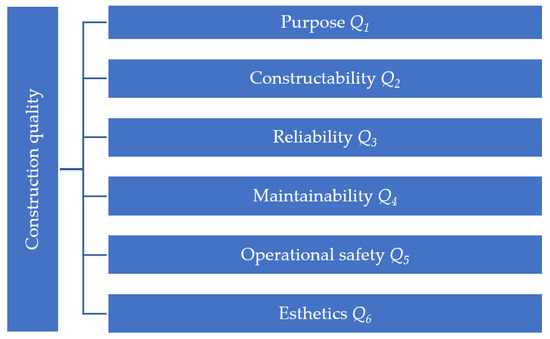
Figure 1.
Construction quality assessment criteria.
Construction defects are broken down into three categories according to the degree of danger: permissible, significant, and critical. A critical defect is a defect in which normal operation of the structure is impossible.
This paper proposes the danger assessment of a defect using a risk-based approach [56],
where is the construction defect, is the probability of damage from the defect, and is the damage from the defect.
Defect damage should be assessed against the criteria detailed in Figure 1. At the same time, each defect can deteriorate construction quality in terms of a number of criteria.
The defect risk for each criterion can be considered separately. An expert at the construction site assesses the defect against one of the criteria, choosing the most significant. Evaluation against several criteria is a difficult task for any expert. If there are several defects, their simultaneous impact on construction quality is even more difficult to assess for any expert. Multi-criteria assessment requires the use of mathematical models.
Multi-criteria assessment of the impact of defects on construction quality using a risk-based approach also requires building a risk tree, as presented in Figure 2 in its general form. Building a risk tree or an event tree presents the overall risk as a system of elementary risks, then highlights all the main risk factors—events leading to damage, and group them according to the nature of the impact on elementary risks. Thus, building a risk tree or an event tree structures the overall risk [57,58,59].
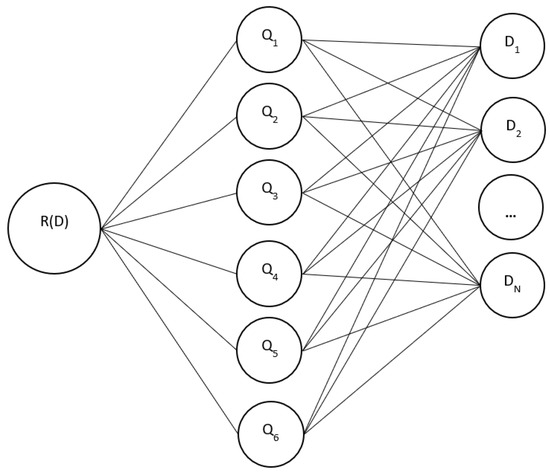
Figure 2.
Tree of construction quality risks due to defects.
According to the resulting tree, construction quality risk against one criterion can be calculated using the following formula:
The total risk against all criteria is calculated according to the following formula:
Depending on the type of construction, and the type and purpose of building structures, various defects can affect the quality as assessed against a limited number of criteria Q. Each defect has an impact on the maintainability of the structure, and defects in concealed works have a greater impact on maintainability than defects of finished surfaces. Let us take the construction of load-bearing cast-in-place reinforced concrete structures as an example. The “reduced number or diameter of reinforcing bars” defect only has an impact against four criteria: Q1, Q3, Q4, and Q5. Therefore, the number of links or their weights in the risk tree will vary depending on the type of work and type of defects. An artificial neural network (ANN) methodology was used for mathematical interpretation of the resulting model. The structure of the resulting risk tree with a large number of connections is accurately interpreted using the ANN methodology. ANNs are an effective tool for multi-objective optimization, because they work well with a large set of input values and are suitable for approximating various dependencies. These features make ANNs preferable for the mathematical formalization of a hierarchical structure, when it is not possible to set a rule for each node, or it is incorrect to use recursive binary splitting (as, for example, in the decision tree model). ANNs are a flexible model and when the structure changes, for example, with an exclusion of one or more neurons from the hidden layer, they can effectively learn from existing samples of precedents, which also make them preferable for the decision tree model. This property is important because, for various building structures, the number of the most important quality criteria Q, used for the evaluation of defects, will change. Additionally, the structure of the resulting risk tree with a large number of links is well interpreted by the ANN structure. ANNs consist of three layers: the first layer is the network input values (defects); the second layer is neuron Q (quality criteria); and the third layer consists of one neuron R (defect risk). The input layer is the defects of the structure. A separate ANN is developed for each separate type of construction work. To determine the number of ANN inputs, it is necessary to classify defects for each type of construction processes by type of impact on the quality criteria Q. Table 1 shows the classification of defects for load-bearing cast-in-place reinforced concrete structures.

Table 1.
Classification of defects in cast-in-place reinforced concrete structures.
This classifier defines the quality criteria that are affected by defects. Each defect generates six input values according to the number of quality criteria. The estimated potential damage from defect D1 against quality criterion Qn is the input value of neuron Qn. If, according to the classifier, a defect does not affect a certain criterion, then the input value from such defect for such neuron will be equal to 0. Potential damage is estimated on a scale from 0 to 1 according to Table 2.

Table 2.
Classification of defects of cast-in-place reinforced concrete structures by the degree of potential damage.
Classification of a defect into categories from Table 2 depends on many factors. For example, the potential damage from a crack in a reinforced concrete structure depends on the width of its opening, surface requirements, the nature of the opening (branched ends or not), location in the structure (tensile or compressed zone), orientation (inclined with reinforcement intersection, longitudinal along the reinforcement), etc. Therefore, an assessment of defect damage requires a separate research study. However, at the construction stage, especially during the rebuilding of destroyed cities, decisions need to be made fast; thus, only three categories are selected for damage assessment, according to Table 2.
Let us take defect No. 4 “Areas of Discontinuous Concrete” in Figure 3 as an example. Defect “a” has a vector of input values ; defect “b” generates the following vector of input values: .
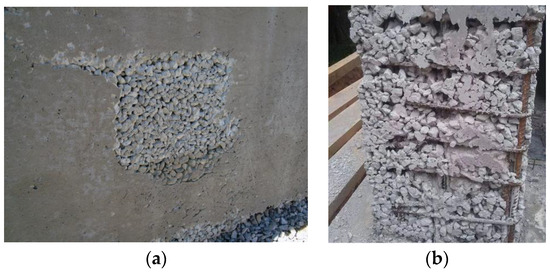
Figure 3.
Classification of defects at the input to the ANN, with an estimation of defect damage. (a) Defect No. 4, for Q1, Q3—significant defect, for Q5, Q6—permissible defect, for Q4—critical defect. (b) Defect No. 4, for Q1, Q3, Q4—critical defect, for Q5—significant defect, for Q6—permissible defect.
Therefore, a vector of values corresponding to the damage category for each criterion, which is the input vector of ANN signals, is assigned to each defect in the classifier. Then, the input signals are sent via synapses to the corresponding neuron Qn, which is affected by the defect. Each link in the ANN has its own weight, , by which the input signal is multiplied. The link weight at the first layer of the ANN is the probability of potential damage from defect Di as assessed against criterion Qn.
The probability of potential damage is estimated using Bayes’ theorem
where is the predicted (a posteriori) probability of damage as assessed against criterion Qn on occurrence of the ith defect; is the a priori probability of damage due to the ith defect, which probability indicates how often damage to the structure is caused by the ith defect; is the probability of damage for this quality criterion for the relevant structures; and is the a priori probability of the ith defect.
Therefore, a signal comes from one defect to each neuron Qn, representing the elementary risk for such quality criterion, as calculated by Equation (1). If several defects are detected, the neuron may receive several signals as shown in Figure 4. Then, the neuron Qn adder sums up the elementary risks from all detected defects using Equation (2). The induced local field of neuron then enters the activation function of neuron Qn, which is taken as a classical logistic function.
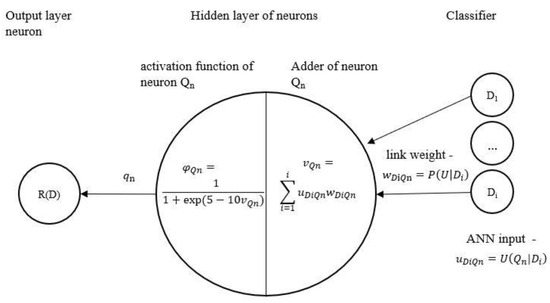
Figure 4.
Functioning of neuron Qn of the artificial neural network.
The coefficients of the logistic function of activating neurons Qn of the ANN’s hidden layer are selected in such a way that the area of the neuron output values should be within the range from 0 to 1. Then, the output of each neuron of the hidden layer qn is fed into one neuron of the ANN output layer, R, along the relevant links. Each link has its own weight, , which reflects the significance of each quality criterion for a particular structure. These weights will vary depending on the type of structures, the risk of defects of which is measured by the ANN. Neuron R sums up all risks for each criterion according to Equation (3), considers the significance coefficients of each criterion, , as shown in Figure 5.
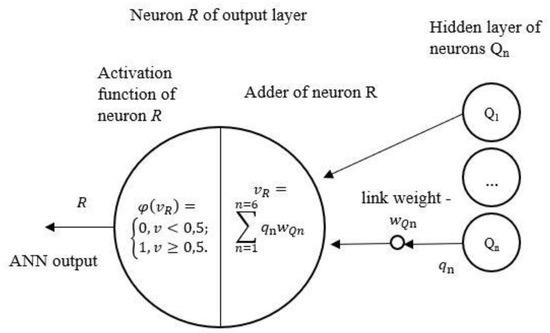
Figure 5.
Functioning of the output neuron R of the artificial neural network.
Then, using the Heaviside Step Activation Function, neuron R generates “0” or “1”, which mean a low risk of construction defect or a high risk of construction defect, respectively. The resulting ANN predicts whether a construction defect will occur as a result of a detected defect or group of defects. This facilitates making a decision to fix a defect or to recognize it as a “permissible defect” and save time on rework.
The methodology for implementing a decision support system based on the significance of a defect is shown in Figure 6. Notably, after training the ANN for a certain type of building structure according to the specified quality criteria, the decision support system will function throughout the construction without the need for retraining. Therefore, the first step of the algorithm in Figure 6 is applied only at the beginning of construction when adapting the ANN for a certain type of building structure at a specific site.
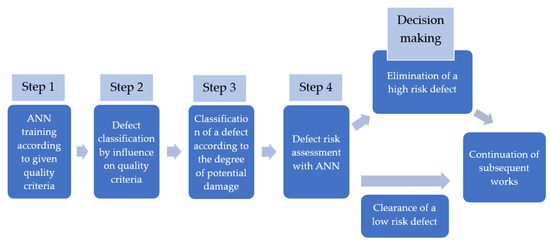
Figure 6.
Methodological diagram for the implementation of the decision support system.
4. Results
This section presents the implementation of the developed decision support system based on an ANN. According to the methodological diagram in Figure 6, the first step is to perform ANN training for a certain type of building structures according to specified criteria. ANN training is performed in two stages: the first stage, preliminary training, consists of determining a posteriori damage probabilities from the main types of defects, which are the initial connection strength of the ANN; in the second stage, additional training of the ANN is performed on a sample of precedents with a check of the predictive validity on a validation set.
4.1. Preliminary Training of ANNs
The ANN was adapted and trained for cast-in-place reinforced concrete structures in multi-story buildings. In the ANN’s preliminary training stage, the initial weights of links of the first and second ANN layers were established. The weights denoting the significance of criterion Q for the relevant type of construction products were determined through a survey among 32 experts. The experts included employees of companies performing construction supervision and EPCM contractor functions. The results of the survey after statistical data processing (removal of outliers) are shown in Figure 7. Thus, we can conclude that the most significant quality criteria for cast-in-place reinforced concrete structures include purpose Q1, reliability Q3, and constructability Q2.
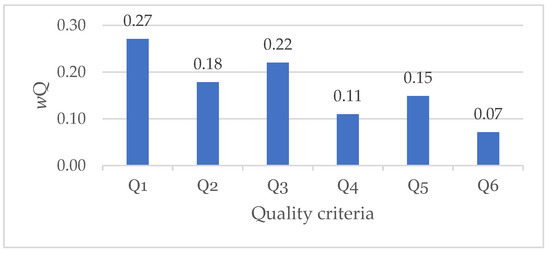
Figure 7.
Results of the expert survey on the significance of quality criteria for cast-in-place reinforced concrete structures with weights of the ANN’s second layer links.
The weights of links of the ANN’s first input layer are found using Equation (4). For this purpose, the probabilities of damage for cast-in-place reinforced concrete structures from defects listed in Table 1 were first found for each of the six criteria Q. During the second round of the expert survey, the experts were asked a question: “Which quality criterion is most often affected when cast-in-place reinforced concrete structures are damaged during their operation (owners’ complaints, defects found as a result of an expert review, surveys, etc.)?” The experts ranked six quality criteria as shown in Figure 1, relative to each other. The results of the survey after statistical data processing (removal of outliers) are shown in Figure 8. Relative probabilities of damage for each of the criteria were obtained, which can be used to judge which quality criteria are more likely to cause damage. The results lead us to a conclusion that damage to cast-in-place reinforced concrete structures can most often be qualified under the first three quality criteria Q1, Q2, and Q3.
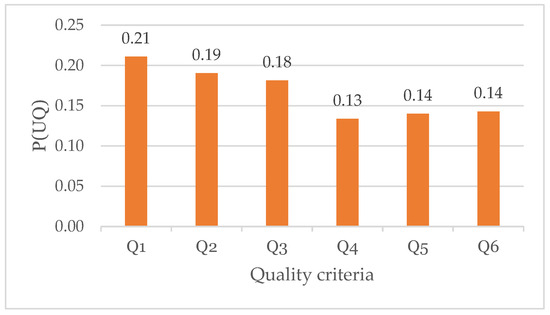
Figure 8.
Damage probability to cast-in-place reinforced concrete structures during operation against six quality criteria.
The probability of each defect listed in Table 1 was also determined during the third round of the expert survey. In this case, the experts assigned a score from 1 to 10, where each score correlated with the frequency of defect occurrence, expressed verbally: 1—“I have never met such a defect in my practice”; 2—“very rarely (once or twice during a construction project)”; 3–4—“rarely (every four to five floors)”; 5–6—“from time to time” (on one or two floors); 7–8—“often” (on every floor); and 9–10—“constantly” (in almost every structure). The results of the survey after statistical data processing (removal of outliers) are shown in Figure 9 and labeled as P1(D).
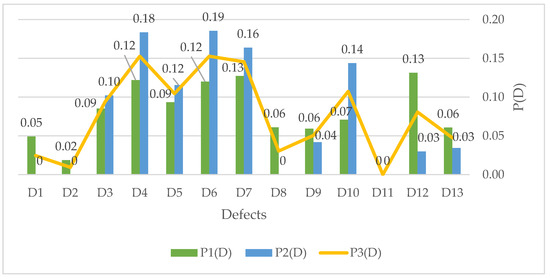
Figure 9.
Defect probability during the construction of cast-in-place reinforced concrete structures of multi-story buildings.
Defect probability was also established experimentally through a statistical analysis of registers of non-conformance reports generated by the construction supervision service during the construction of twelve multi-story buildings in Moscow. An array of statistical data on quality breaches with respect to cast-in-place reinforced concrete structures found in the archives of a construction company performing the EPCM contractor and construction supervision functions was analyzed and processed. The relative defect probability was calculated using the following formula:
where NDi is the number of occurrences of the ith defect during the construction of cast-in-place reinforced concrete structures, and Nd is the total number of defects in cast-in-place reinforced concrete structures. The probability of defects listed in Table 1 occurring at each construction site was calculated using Equation (5). Figure 8 shows defect probabilities averaged over 12 construction projects and labeled as . Both methods used the above to determine the probability with their advantages and disadvantages. An expert opinion can highlight patterns, but it can be biased; statistical data are unbiased, but a significant number of defects and violations are not entered into the database, as many defects are fixed “in the here and now” during the delivery and acceptance of a completed project and they are not reflected in non-conformance reports. Taking this into account, in order to obtain more reliable values of probabilities , the probabilities obtained by the two above methods can be averaged to address defect probabilities, denoted in Figure 8 as .
To determine the a priori probability of damage due to the ith defect, it is necessary to determine the frequency at which the defect causes damage. Damage caused by construction defects is more often manifested in the stage of the building’s operation and the cause of such damage is established during the inspection of buildings and structures before major repairs or rebuilding, or after destruction caused by natural disasters [10] or warfare. To determine this probability, another second expert survey was conducted among 28 experts involved in building and structure inspections. In this survey, the experts gave a score from 1 to 10, where each score correlated with the frequency of defect occurrence during the inspection of buildings and structures, expressed verbally as: 1—“I have never met such a defect in my inspection practice”; 2—“very rarely (not more than 10 cases over my entire practice)”; 3–4—“rarely (every three to four inspections)”; 5–6—“from time to time (in one or two inspections)”; 7–8—“often (during every inspection)”, and 9–10—“very often (several times per every inspection)”. The results of the survey after statistical data processing (removal of outliers) are shown in Table 3. This table also presents the results of calculating a posteriori probabilities of damage caused by defects, as assessed against the purpose criterion Q1 according to Equation (4).

Table 3.
Results of calculating a priori and a posteriori probabilities of damage caused by construction defects in cast-in-place reinforced concrete structures, as assessed against criterion Q1 (purpose).
4.2. ANN Training
The ANN was trained and verified for the convergence of data to monitor the quality of cast-in-place reinforced concrete structures. Expert surveys, the results of which are presented above, showed that three criteria were of the greatest importance: purpose Q1, constructability Q2, and reliability Q3. Given the purpose of our study, we will discard the other quality criteria and train the ANN on the most significant criteria.
Retrieving a training sample for the study’s subject is a very labor-intensive process. The ANN input is the construction defects, and the ANN output is the risk of construction defects. In this study, the risk could take two values: ANN output is “1”—the structure needs to be redone; and ANN output is “0”—the structure can be operated. The authors analyzed more than 100 orders from construction supervision services from 12 different construction projects, after which the structure was redone (ANN output is “1”) or kept the same (ANN output is “0”). Photographs of defects were selected to evaluate the defects according to Table 2 (ANN input). Thus, a sample of 40 precedents was obtained.
A lot of time can pass between events such as the “occurrence of a defect during construction” and “defective construction” that cannot be operated. Part of the training sample array was retrieved from the materials of inspections of buildings and structures before major repairs and rebuilding. During the visual inspection of cast-in-place reinforced concrete structures of various buildings and structures, a defect of the building structure was recorded (ANN output is “1”); this defect made further safe operation no longer possible. Then, during a more detailed inspection its cause is determined, which is quite often a construction defect, as listed in Table 1. The training sample was composed of defects (ANN output is “1”) actually recorded in cast-in-place reinforced concrete structures and defects that caused such consequences. Defects were assessed against each criterion in accordance with Table 2. Ten reports of technical inspection of buildings and structures were analyzed, from which construction defects were identified that led to unsafe operation (ANN output of “1”), and those which did not affect the operation of structures (ANN output of “0”).
As a result, a sample with a length L = 60 precedents was generated in this way. For training, we divided the sample into a learning sample with a length Ltrain = 50 precedents, and a test sample with a length Ltest = 10.
Considering the small size of the training sample, we applied statistical bootstrap technology [60] to expand it. The length of the bootstrap sample was equal to the length of the training sample. The ANN was trained using the bootstrap aggregating technology [61], which consisted of training the ANN on several separate bootstrap samples and further averaging the generated weights. The ANN’s convergence process, including the calculation of the mean square error (MSE) on the train and test samples, is shown in Figure 10. The quality of the ANN’s training was verified using cross-validation [62], and the ANN featuring the lowest MSE was selected, which required 10 bootstrap samples for training. To control overfitting, we used the sixfold cross-validation method. The resulting six models had approximately the same MSE in the range of 0–0.2.
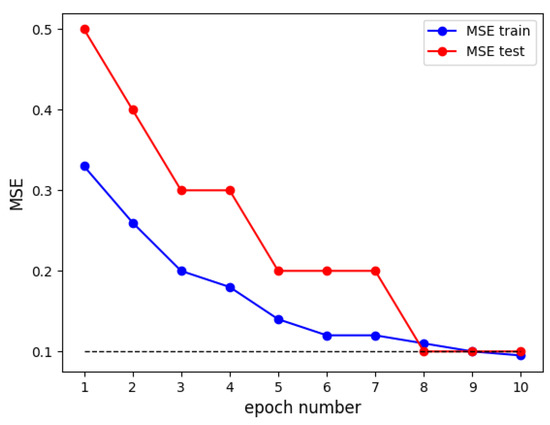
Figure 10.
Convergence of the ANN and MSE data.
The convergence of the ANN data demonstrated by the test sample indicated that the model had been successfully trained. Convergence of the ANN was achieved; therefore, the error value can be taken as a random variable distributed according to the normal law of distribution. Then, it is possible to calculate the upper confidence limit of the error through estimation of the expected value E(ε) of error ε on the control sample according to the formula
where is the arithmetic mean error, is the value for t-distribution with the number of degrees of freedom , and is the corrected sample standard deviation.
For an ANN that did not give errors on the control sample, the upper limit of the expected value according to Equation (6) is 0.11 with a confidence level of 85%, which means that the developed ANN in 85% of cases will give a correct prediction or make a mistake 1 time out of 10. The prediction reliability of the trained ANN was 85% on the test sample, which is quite high, given the small sample of precedents. The results indicate that the use of the generated model to predict the significance of a construction defect was effective. This result was ensured due to pre-training of the ANN.
5. Discussion
The proposed classification of defects according to quality criteria specifies the type of damage from this defect, which contributes to a more reliable assessment of defect significance.
Compared with previous studies, the authors have developed an artificial neural network that predicts the significance of structural defects according to several quality criteria. Multi-criteria defect risk assessments enable a more complete analysis of defect significance. The obtained model features an ability to select the criteria that are most important for a particular case, and to assess the risk of defects according to these criteria. The ANN methodology facilitates an easier and faster adaptation of the resulting model for various construction projects due to the high ability of ANNs to learn. This study found a posteriori damage probabilities from the main defects during the construction of monolithic reinforced concrete structures, which represent a scientific novelty and can be used to classify defects according to the degree of potential damage. This result is useful both to civil engineers for solving practical daily tasks at construction sites, and for further theoretical research, including the development of quality standards and professional guidance. Using obtained posterior probabilities to pre-tune the ANN link weights confirmed the effectiveness of this method for further ANN training to predict the risk of defects.
We were able to use the generated model to reliably determine whether the detected defect would lead to a failure of cast-in-place reinforced concrete structures or not. The ANN model also enabled automation of the defect risk assessment process, which allowed faster decision-making, as compared with existing methods, on whether rework is needed or the defect is permissible. The obtained results will speed up the decision-making process for assessing the significance of defects that appear during the construction of monolithic reinforced concrete structures, and will help to avoid redoing work with defects that have low risk to further structure operation. Thus, the decision support model developed in the study can help to reduce the duration of construction projects.
The above advantages are of particular importance when rebuilding destroyed cities, because reducing the duration of construction while maintaining a sufficient level of quality contributes to the earliest return of residents, the normalization of urban environment functioning, and reductions in social and economic tension.
6. Conclusions
This study has developed a model for the calculation and assessment of construction defect risks. The model serves as the basis for a decision support system for the organization of construction quality control during the rebuilding of destroyed cities. Currently, the model is being tested at a construction company involved in the rebuilding of the city of Mariupol after warfare. The results of the study can organize a quality control system that will ensure construction project effectiveness in terms of its timing, while also ensuring a sufficient level of quality for the normal operation of facilities. The quality control system proposed in the study has the following practical significance:
- Reducing construction duration due to reduced costs of defect rework with a low risk level;
- Reduction in time for decision-making on defect criticality assessments;
- Reduction in financial costs by involving fewer experts for defect criticality assessments.
The methodology presented in the article and the results obtained are of theoretical significance for the classification of defects in the development of quality standards and professional guidance, and an approach has been proposed to organize a quality control system based on how the risk of a defect contributes to the theoretical development of areas of knowledge such as construction quality management and construction management in the context of rebuilding destroyed cities.
Further research will require adapting and training the resulting ANN on other key construction processes.
Author Contributions
Conceptualization, A.L.; methodology, A.L. and A.M.; software, A.K.; validation, A.L., A.M. and A.K.; formal analysis, A.M.; investigation, A.L. and A.M.; resources, A.L.; data curation, A.K.; writing—original draft preparation, A.M.; writing—review and editing, A.M. and A.K.; visualization, A.M.; supervision, A.L.; project administration, A.K.; funding acquisition, A.L. All authors have read and agreed to the published version of the manuscript.
Funding
This work was financially supported by the Ministry of Science and Higher Education of Russian Federation (grant # 075-15-2021-686). Tests were carried out using research equipment of The Head Regional Shared Research Facilities of the Moscow State University of Civil Engineering.
Data Availability Statement
Not applicable.
Conflicts of Interest
The authors declare no conflict of interest.
References
- Diaz, R.; Behr, J.; Acero, B. Coastal housing recovery in a postdisaster environment: A supply chain perspective. Int. J. Prod. Econ. 2022, 247, 108463. [Google Scholar] [CrossRef]
- Hamideh, S.; Peacock, W.; Van Zandt, S. Housing type matters for pace of recovery: Evidence from Hurricane Ike. Int. J. Disaster Risk Reduct. 2021, 57, 102149. [Google Scholar] [CrossRef]
- Lin, C.-L.; Chen, B.-K. Research for Risk Management of Construction Projects in Taiwan. Sustainability 2021, 13, 2034. [Google Scholar] [CrossRef]
- Bhandari, S.; Riggio, M.; Jahedi, S.; Fischer, E.; Muszynski, L.; Luo, Z. A review of modular cross laminated timber construction: Implications for temporary housing in seismic areas. J. Build. Eng. 2023, 63, 105485. [Google Scholar] [CrossRef]
- Maracchini, G.; D’Orazio, M. Improving the livability of lightweight emergency architectures: A numerical investigation on a novel reinforced-EPS based construction system. Build. Environ. 2022, 208, 108601. [Google Scholar] [CrossRef]
- Faragallah, R. Fundamentals of temporary dwelling solutions: A proposed sustainable model for design and construction. Ain Shams Eng. J. 2021, 12, 3305–3316. [Google Scholar] [CrossRef]
- Komatsuzaki, N.; Otsuyama, K.; Hiroi, U. How the choice of temporary housing impacts on widespread displacement after large-scale flooding? A disaster recovery simulation in Tokyo metropolitan area. Int. J. Disaster Risk Reduct. 2022, 81, 103243. [Google Scholar] [CrossRef]
- Qin, M.; Chew, B.; Yau, Y.; Yang, Z.; Han, X.; Chang, L.; Liu, Y.; Pan, S. Characteristic analysis and improvement methods of the indoor thermal environment in post-disaster temporary residential buildings: A systematic review. Build. Environ. 2023, 235, 110198. [Google Scholar] [CrossRef]
- Faculty of Societal Safety Sciences (Ed.) Chapter 3—Current Status of Rebuilding Houses and Reconstructing Local Regions after the Great East Japan Earthquake. In The Fukushima and Tohoku Disaster; Butterworth-Heinemann: Oxford, UK, 2018; pp. 47–69. [Google Scholar] [CrossRef]
- Messaoudi, M.; Nawari, O. BIM-based Virtual Permitting Framework (VPF) for post-disaster recovery and rebuilding in the state of Florida. Int. J. Disaster Risk Reduct. 2019, 42, 101349. [Google Scholar] [CrossRef]
- Das, A.; Haldar, A. Health assessment of structures exposed to seismic excitations. ISET J. Earthq. Technol. 2011, 48, 11–27. [Google Scholar]
- Fayazi, M.; Lizarralde, G. Conflicts between recovery objectives: The case of housing reconstruction after the 2003 Earth quake in Bam, Iran. Int. J. Disaster Risk Reduct. 2017, 27, 317–328. [Google Scholar] [CrossRef]
- Haddow, G.; Bullock, J.; Coppola, D. The Disciplines of Emergency Management: Recovery. In Introduction to Emergency Management, 6th ed.; Butterworth-Heinemann: Oxford, UK, 2017; pp. 281–330. [Google Scholar] [CrossRef]
- Mercader-Moyano, P.; Camporeale, P.; Serrano-Jiménez, A. Integrated urban regeneration for high-rise multi-family buildings by providing a multidimensional assessment model and decision support system. J. Build. Eng. 2023, 76, 107359. [Google Scholar] [CrossRef]
- Mukilan, K.; Rameshbabu, C.; Velumani, P. A modified particle swarm optimization for risk assessment and claim management in engineering procurement construction projects. Mater. Today Proc. 2021, 42, 786–794. [Google Scholar] [CrossRef]
- He, X.; Jeong, C.E. Modeling the damage and recovery of interdependent critical infrastructure systems from natural hazards. Reliab. Eng. Syst. Saf. 2018, 177, 162–175. [Google Scholar] [CrossRef]
- Ebekozien, A.; Aigbavboa, C.; Samsurijan, M.; Firdaus, R.; Ayo-Odifiri, S.; Amadi, G. Disasters recovery and rehabilitation in informal settlements: The role of fourth industrial revolution technologies. Int. J. Constr. Manag. 2023, 2023, 1–11. [Google Scholar] [CrossRef]
- Egorochkina, I.; Shlyakhova, E. Express Method of Examination of Construction Units of Buildings and Structures. In Networked Control Systems for Connected and Automated Vehicles; Springer: Cham, Swizterland, 2022; Volume 509. [Google Scholar] [CrossRef]
- Huang, X.; Bei, Y.; Sui, L.; Li, L.; Hu, B.; Zhou, Y. Reliability assessment on maximum crack width of concrete beams reinforced with high-strength steel bars. J. Build. Eng. 2022, 45, 103564. [Google Scholar] [CrossRef]
- Senthil, J.; Muthukannan, M. Predication of construction risk management in modified historical simulation statistical methods. Ecol. Inform. 2021, 66, 101439. [Google Scholar] [CrossRef]
- Abdollahzadeh, G.; Rastgoo, S. Risk Assessment in Bridge Construction Projects Using Fault Tree and Event Tree Analysis Methods Based on Fuzzy Logic. ASCE-ASME J. Risk Uncert. Engrg. Sys. Part B Mech. Eng. 2015, 1, 031006. [Google Scholar] [CrossRef]
- Renuka, S.; Kamal, S.; Umarani, C. A model to estimate the time overrun risk in construction projects. Empir. Res. Urban Manag. 2017, 12, 64–76. [Google Scholar]
- Kozień, E.; Kozień, M. Ex-Ante Risk Estimation in the Production Project. Syst. Saf. Hum. Tech. Facil. Environ. 2019, 1, 708–715. [Google Scholar] [CrossRef]
- Enny, M.; Purba, H. Construction Project Risk Analysis Based on Fuzzy Analytical Hierarchy Process (F-AHP): A Literature Review. Adv. Res. Civ. Eng. 2021, 3, 1–20. [Google Scholar]
- Belal, A.; Shcherbina, E. Heritage in post-war period challenges and solutions. IFAC Pap. 2019, 52, 252–257. [Google Scholar] [CrossRef]
- Junichi, K.; Masayuki, K.; Shinji, M.; Hideaki, T.; Torajiro, F. Damage to railway earth structures and foundations caused by the 2011 off the Pacific Coast of Tohoku Earthquake. Soils Found. 2012, 52, 872–889. [Google Scholar] [CrossRef]
- Lozano, J.; Tien, I. Data collection tools for post-disaster damage assessment of building and lifeline infrastructure systems. International. J. Disaster Risk Reduct. 2023, 94, 103819. [Google Scholar] [CrossRef]
- Goyal, P.; Datta, T. Effect of wind directionality on the vulnerability of rural houses due to cyclonic wind. Nat. Hazards Rev. 2013, 14, 258–267. [Google Scholar] [CrossRef]
- Fujiwara, T.; Suzuki, Y.; Kitahara, A. Risk management for urban planning against strong earthquakes. In Post-Earthquake Rehabilitation and Reconstruction; Cheng, F., Wang, Y., Eds.; Pergamon Press: Oxford, UK, 1996; pp. 131–145. [Google Scholar] [CrossRef]
- Owen, J. Windborne debris in the urban environment. Tech. Trans. 2015, 112, 145–165. [Google Scholar]
- Mashwama, N.; Aigbavboa, C.; Thwala, D. An Assessment of the Critical Success factor for The Reduction of Cost of Poor Quality in Construction Projects in Swaziland. Procedia Eng. 2017, 196, 447–453. [Google Scholar] [CrossRef]
- Oshungade, O.; Kruger, D. A comparative study of causes and effects of project delays and disruptions in construction projects in the south african construction industry. J. Constr. Eng. Proj. Manag. 2017, 7, 13–25. [Google Scholar] [CrossRef]
- Adeyemi, A.; Masalil, K. Delay Factors and Time-Cost Performance of Construction Projects in Gaborone City Council, Botswana. J. Adv. Perform. Inf. Value 2016, 8, 4–18. [Google Scholar] [CrossRef]
- Viles, E.; Rudell, N.; Santilli, A. Causes of delay in construction projects: A quantitative analysis. Eng. Constr. Archit. Manag. 2019, 27, 917–935. [Google Scholar] [CrossRef]
- Qudah, A.; Battaineh, H. Causes of construction delay: Traditional contracts. Int. J. Proj. Manag. 2002, 20, 67–73. [Google Scholar] [CrossRef]
- Tahmasebinia, F. Significant Factors Causing Delay in the Cambodian Construction Industry. Sustainability 2022, 14, 3521. [Google Scholar] [CrossRef]
- Adamu, N. Time implication of delays in construction projects in Addis Ababa city. SSRN Electron. J. 2022, 2022, 1–17. [Google Scholar] [CrossRef]
- Mamdouh, M.; Tran, D. Risk-based inspection for concrete pavement construction using fuzzy sets and bayesian networks. Autom. Constr. 2021, 128, 103761. [Google Scholar] [CrossRef]
- Love, P.; Matthews, J. Quality, requisite imagination and resilience: Managing risk and uncertainty in construction. Reliability Eng. Syst. Saf. 2020, 204, 107172. [Google Scholar] [CrossRef]
- Chen, L.; Lu, Q.; Han, D. A Bayesian-driven Monte Carlo approach for managing construction schedule risks of infrastructures under uncertainty. Expert Syst. Appl. 2023, 212, 118810. [Google Scholar] [CrossRef]
- Nasirzadeh, F.; Kashi, M.; Khanzadi, M.; Carmichael, D.; Akbarnezhad, A. A hybrid approach for quantitative assessment of construction projects risks: The case study of poor quality concrete. Comput. Ind. Eng. 2019, 131, 306–319. [Google Scholar] [CrossRef]
- Ma, G.; Wu, M.; Wu, Z.; Yang, W. Single-shot multibox detector- and building information modeling-based quality inspection model for construction projects. J. Build. Eng. 2021, 38, 102216. [Google Scholar] [CrossRef]
- Chow, J.; Liu, K.; Tan, P.; Su, Z.; Wu, J.; Li, Z.; Wang, Y. Automated defect inspection of concrete structures. Autom. Constr. 2021, 132, 103959. [Google Scholar] [CrossRef]
- Hüthwohl, P.; Lu, R.; Brilakis, I. Multi-classifier for reinforced concrete bridge defects. Autom. Constr. 2019, 105, 102824. [Google Scholar] [CrossRef]
- Chew, M. Defect analysis in wet areas of buildings. Constr. Build. Mater. 2005, 19, 165–173. [Google Scholar] [CrossRef]
- Uchaeva, T.V.; Loganina, V.I. Analysis of the risk at the finishing of the building products and construction of paint compositions. Case Stud. Constr. Mater. 2018, 8, 213–216. [Google Scholar] [CrossRef]
- May, K.W.; KC, C.; Ochoa, J.J.; Gu, N.; Walsh, J.; Smith, R.T.; Thomas, B.H. The Identification, Development, and Evaluation of BIM-ARDM: A BIM-Based AR Defect Management System for Construction Inspections. Buildings 2022, 12, 140. [Google Scholar] [CrossRef]
- Yoon, S.; Son, S.; Kim, S. Design, Construction, and Curing Integrated Management of Defects in Finishing Works of Apartment Buildings. Sustainability 2021, 13, 5382. [Google Scholar] [CrossRef]
- Lapidus, A.; Topchiy, D.; Kuzmina, T.; Shesterikova, Y.; Bidov, T. An integrated quality index of high-rise residential buildings for all lifecycle stages of a construction facility. Appl. Sci. 2023, 13, 2014. [Google Scholar] [CrossRef]
- Lapidus, A.; Topchiy, D.; Kuzmina, T.; Chapidze, O. Influence of the Construction Risks on the Cost and Duration of a Project. Buildings 2022, 12, 484. [Google Scholar] [CrossRef]
- Lapidus, A.A.; Makarov, A.N. Risk-based approach for the organization of construction supervision of the developer. AIP Conf. Proc. 2022, 2559, 060003. [Google Scholar] [CrossRef]
- Makarov, A. Organization of construction quality control based on a priori risks of works. International. J. Eng. Trends Technol. 2023, 71, 134–140. [Google Scholar] [CrossRef]
- Meijer, F.; Visscher, H. Quality control of constructions: European trends and developments. Int. J. Law Built Environ. 2017, 9, 143–161. [Google Scholar] [CrossRef][Green Version]
- Baiburin, A. Civil Engineering Quality Assessment in Terms of Construction Safety Index. Procedia Eng. 2017, 206, 800–806. [Google Scholar] [CrossRef]
- Park, Y.-J.; Yi, C.-Y. Resource-Based Quality Performance Estimation Method for Construction Operations. Appl. Sci. 2021, 11, 4122. [Google Scholar] [CrossRef]
- ISO 13824:2009; Bases for Design of Structures—General Principles on Risk Assessment of Systems Involving Structures. International Organization for Standardization (ISO): Geneva, Switzerland, 2009.
- Kaneko, F.; Yuzui, T. Novel method of dynamic event tree keeping the number of simulations in risk analysis small. Reliab. Eng. Syst. Saf. 2023, 231, 109009. [Google Scholar] [CrossRef]
- Yılmaz, E.; German, B.; Pritchett, A. Optimizing resource allocations to improve system reliability via the propagation of statistical moments through fault trees. Reliab. Eng. Syst. Saf. 2023, 230, 108873. [Google Scholar] [CrossRef]
- Andrews, J.; Tolo, S. Dynamic and dependent tree theory (D2T2): A framework for the analysis of fault trees with dependent basic events. Reliab. Eng. Syst. Saf. 2023, 230, 108959. [Google Scholar] [CrossRef]
- Efron, B. Bootstrap methods: Another look at the Jackknife. Ann. Stat. 1979, 7, 1–26. [Google Scholar] [CrossRef]
- Breiman, L. Bagging predictors. Mach. Learn. 1996, 24, 123–140. [Google Scholar] [CrossRef]
- Tibshirani, R.; Tibshirani, R. A bias correction for the minimum error rate in cross-validation. Ann. Appl. Stat. 2009, 3, 822–829. [Google Scholar] [CrossRef]
Disclaimer/Publisher’s Note: The statements, opinions and data contained in all publications are solely those of the individual author(s) and contributor(s) and not of MDPI and/or the editor(s). MDPI and/or the editor(s) disclaim responsibility for any injury to people or property resulting from any ideas, methods, instructions or products referred to in the content. |
© 2023 by the authors. Licensee MDPI, Basel, Switzerland. This article is an open access article distributed under the terms and conditions of the Creative Commons Attribution (CC BY) license (https://creativecommons.org/licenses/by/4.0/).